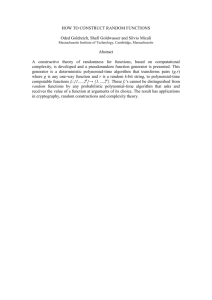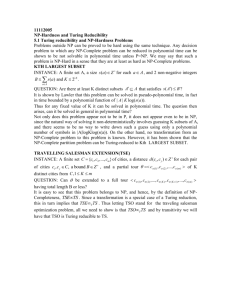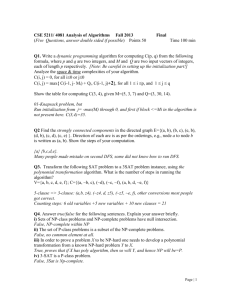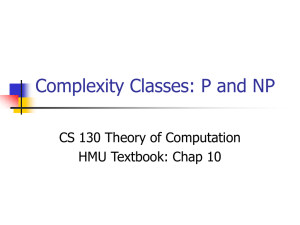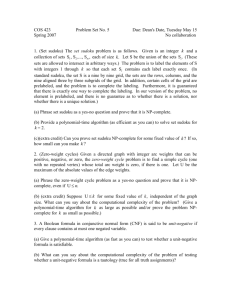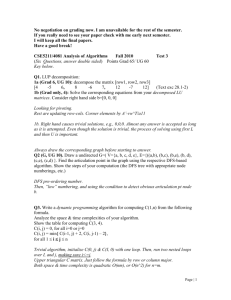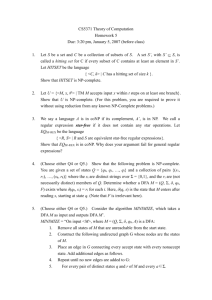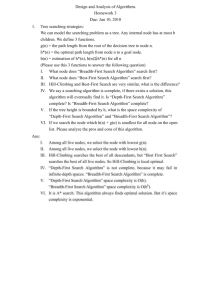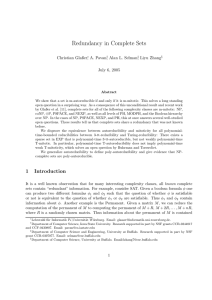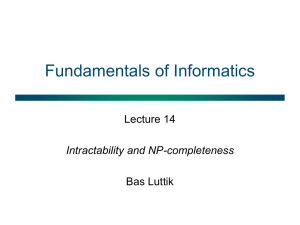Mitosis in Computational Complexity
advertisement
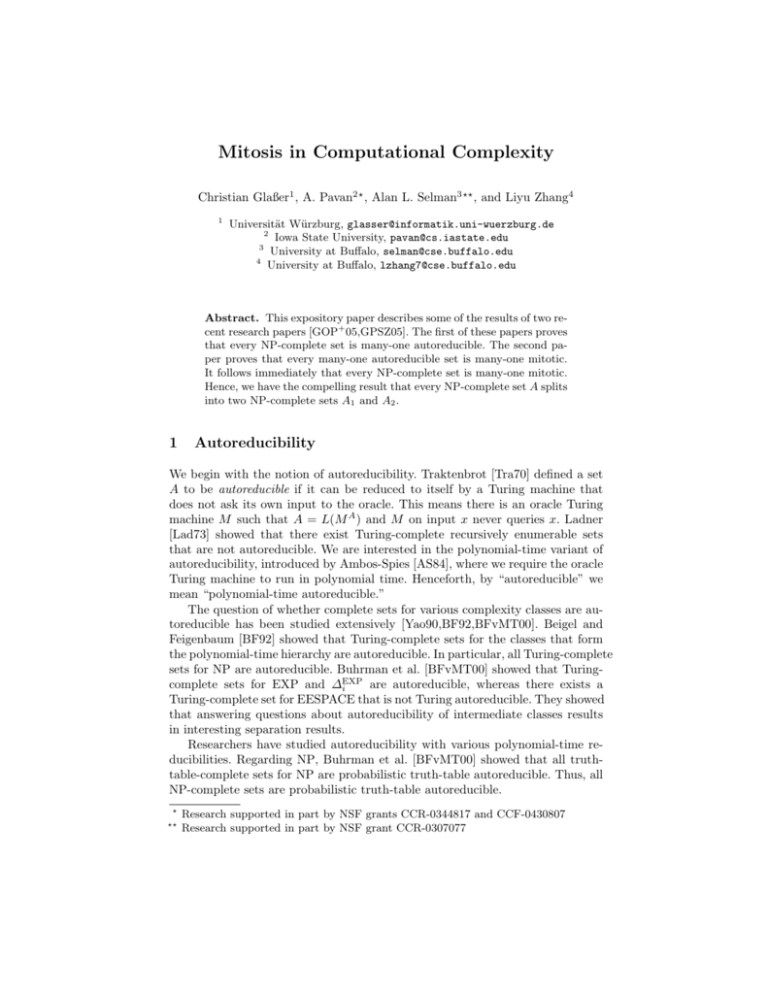
Mitosis in Computational Complexity
Christian Glaßer1 , A. Pavan2? , Alan L. Selman3?? , and Liyu Zhang4
1
Universität Würzburg, glasser@informatik.uni-wuerzburg.de
2
Iowa State University, pavan@cs.iastate.edu
3
University at Buffalo, selman@cse.buffalo.edu
4
University at Buffalo, lzhang7@cse.buffalo.edu
Abstract. This expository paper describes some of the results of two recent research papers [GOP+ 05,GPSZ05]. The first of these papers proves
that every NP-complete set is many-one autoreducible. The second paper proves that every many-one autoreducible set is many-one mitotic.
It follows immediately that every NP-complete set is many-one mitotic.
Hence, we have the compelling result that every NP-complete set A splits
into two NP-complete sets A1 and A2 .
1
Autoreducibility
We begin with the notion of autoreducibility. Traktenbrot [Tra70] defined a set
A to be autoreducible if it can be reduced to itself by a Turing machine that
does not ask its own input to the oracle. This means there is an oracle Turing
machine M such that A = L(M A ) and M on input x never queries x. Ladner
[Lad73] showed that there exist Turing-complete recursively enumerable sets
that are not autoreducible. We are interested in the polynomial-time variant of
autoreducibility, introduced by Ambos-Spies [AS84], where we require the oracle
Turing machine to run in polynomial time. Henceforth, by “autoreducible” we
mean “polynomial-time autoreducible.”
The question of whether complete sets for various complexity classes are autoreducible has been studied extensively [Yao90,BF92,BFvMT00]. Beigel and
Feigenbaum [BF92] showed that Turing-complete sets for the classes that form
the polynomial-time hierarchy are autoreducible. In particular, all Turing-complete
sets for NP are autoreducible. Buhrman et al. [BFvMT00] showed that Turingcomplete sets for EXP and ∆EXP
are autoreducible, whereas there exists a
i
Turing-complete set for EESPACE that is not Turing autoreducible. They showed
that answering questions about autoreducibility of intermediate classes results
in interesting separation results.
Researchers have studied autoreducibility with various polynomial-time reducibilities. Regarding NP, Buhrman et al. [BFvMT00] showed that all truthtable-complete sets for NP are probabilistic truth-table autoreducible. Thus, all
NP-complete sets are probabilistic truth-table autoreducible.
?
??
Research supported in part by NSF grants CCR-0344817 and CCF-0430807
Research supported in part by NSF grant CCR-0307077
A set A is polynomial-time m-autoreducible (m-autoreducible, for short) if
A ≤pm A via a polynomial-time computable reduction function f such that for
all x, f (x) 6= x. Note that m-autoreducibility is a strong form of autoreducibility. If a set is m-autoreducible, then it is T-autoreducible also. Buhrman and
Torenvliet [BT94] asked whether all NP-complete sets are m-autoreducible and
whether all PSPACE-complete sets are m-autoreducible. Glasser et al. [GOP+ 05]
resolve these questions positively. A set L is nontrivial if kLk > 1 and kLk > 1.
The proof that all nontrivial NP-complete sets are m-autoreducible is interesting,
for it uses the left set technique of Ogihara and Watanabe [OW91].
Let L belong to the class NP and let M be a polynomial-time-bounded
nondeterministic Turing machine that accepts L. For a suitable polynomial p,
we can assume that all computation paths v on input x have length p(|x|). Let
Left(L) = {hx, ui |u| = p(|x|) and ∃v, |v| = |u|, such that
u ≤ v and M (x) accepts along path v}.
Notice that Left(L) belongs to the class NP. So if L is NP-complete, then
there is a polynomial-time-computable reduction f from Left(L) to L.
Theorem 1. All nontrivial NP-complete sets are m-autoreducible.
Proof. Let L be NP-complete. As we just described, let M be an NP-machine
that accepts L, let p be a polynomial so that all computation paths of M on an
input x have length p(|x|), and let f be a polynomial-time-computable reduction
from Left(L) to L. Since L is nontrivial, let y1 , y2 ∈ L and y 1 , y 2 ∈ L.
The following algorithm defines a function g to be an m-autoreduction for
L: Let x be an input, and define n = |x| and m = p(|x|).
1
2
3
4
5
6
7
8
9
10
11
12
if f(hx, 0m i) 6= x then output f(hx, 0m i)
if f(hx, 1m i) = x then
if M(x) accepts along 1m then
output a string from {y1 , y2 } − {x}
else
output a string from {y1 , y2 } − {x}
endif
endif
// here f(hx, 0m i) = x 6= f(hx, 1m i)
determine z of length m such that f(hx, zi) = x 6= f(hx, z + 1i)
if M(x) accepts along z then output a string from {y1 , y2 } − {x}
else output f(hx, z + 1i)
Step 10 is accomplished by an easy binary search algorithm: Start with z1 :=
0m and z2 := 1m . Let z 0 be the middle element between z1 and z2 . If f (z 0 ) = x
then z1 := z 0 else z2 := z 0 . Again, choose the middle element between z1 and
z2 , and so on. This shows that g is computable in polynomial time. Clearly,
g(x) 6= x, so it remains to show that L≤pm L via g.
If the algorithm stops in step 1, then
x ∈ L ⇐⇒ hx, 0m i ∈ Left(L) ⇔ g(x) = f (hx, 0m i) ∈ L.
If the algorithm stops in step 4 or step 6, then f (hx, 0m i) = f (hx, 1m i). Hence
x ∈ L ⇐⇒ hx, 1m i ∈ Left(L) ⇐⇒ M (x) accepts along 1m ⇐⇒ g(x) ∈ L.
Assuming we reach step 9, it holds that f (hx, 0m i) = x 6= f (hx, 1m i). If the
algorithm stops in step 11, then x ∈ L and g(x) ∈ L. Now consider the possibility
that the algorithm stops in step 12. We treat two cases:
Assume x 6∈ L. So there is no accepting computation. So hx, z + 1i 6∈ Left(L).
So g(x) = f (hx, z + 1i) 6∈ L also.
Assume x ∈ L. Then f (hx, 0m i) = f (hx, zi) = x ∈ L. The rightmost accepting computation of M on x is to the right of z. So f (hx, z + 1i) ∈ L, because
either z + 1 is accepting or something to its right is accepting. The paper of Glasser et al. extends the basic technique to show that the nontrivial complete sets of several additional complexity classes are m-autoreducible:
⊕P, the levels of the polynomial-time hierarchy, the Boolean hierarchy over NP,
and MODPH.
2
Mitotic Sets
A recursively enumerable set is mitotic if it can be divided into two disjoint r.e.
sets A0 and A1 such that A, A0 , and A1 are all Turing equivalent. The set A
consists of two parts that each contain the same amount of information as the
original set. Ladner [Lad73] showed that autoreducibility and mitoticity coincide
for the r.e. sets.
Ambos-Spies [AS84] defined two notions of mitoticity in the polynomial-time
setting:
Definition 1 (Ambos-Spies). A decidable set A is polynomial-time m(T)mitotic (m(T)-mitotic, for short) if there exists a set B ∈ P such that
A ≡pm(T ) A ∩ B ≡pm(T ) A ∩ B.
A decidable set A is polynomial-time weakly m(T)-mitotic (weakly m(T)-mitotic,
for short) if there exist disjoint sets A0 and A1 such that A0 ∪ A1 = A, and
A ≡pm(T ) A0 ≡pm(T ) A1 .
Ambos-Spies proved that m-mitotic implies m-autoreducible and asked whether
the converse holds. Also, he proved that T-autoreducible does not imply Tmitotic. Buhrman, Hoene, and Torenvliet [BHT98] proved that all m-complete
sets for EXP are weakly m-mitotic, while Glasser et al. [GOP+ 05] strengthened
this result to show that all m-complete sets for EXP are m-mitotic.
The main result of the second paper by Glasser et al. [GPSZ05] settles the
open question of Ambos-Spies with the following result:
Theorem 2 (GPSZ, 2005). Let L be any set such that kLk ≥ 2. L is mautoreducible if and only if L is m-mitotic.
The following corollaries follow immediately:
Corollary 1. Every nontrivial set that is m-complete for one of the following
complexity classes is m-mitotic.
– NP, ⊕P, PSPACE, EXP, NEXP
– any level of the polynomial-time hierarchy, MODPH, or the Boolean hierarchy over NP
The corollary settles several long-standing open questions raised by AmbosSpies [AS84], Buhrman, Hoene, and Torenvliet [BHT98], and Buhrman and
Torenvliet [BT94]. With specific regard to the class NP, we have the following:
Corollary 2. For every nontrivial NP-complete set L, there is a set S ∈ P such
that L ∩ S and L ∩ S are NP-complete.
Corollary 2 holds for all known natural NP-complete sets.5 Our contribution
is that it holds unconditionally for all NP-complete sets.
Corollary 3. A nontrivial set L is NP-complete if and only if L is the union
of two disjoint P-separable NP-complete sets.
The proof of Theorem 2 in one direction is straightforward. However the
proof that m-autoreducible implies m-mitotic is too complex to present here.
Nevertheless, we can illustrate some of the issues that arise in the proof and
suggest how these issues are addressed.
Assume that L is m-autoreducible via reduction function f . Given x, the
repeated application of f yields a sequence of words x, f (x), f (f (x)), . . ., which
we call the trajectory of x. These trajectories either are infinite or end in a cycle
of length at least 2. Note that as f is an autoreduction, x 6= f (x).
At first glance it seems that m-mitoticity can be easily established by the
following idea: In every trajectory, label the words at even positions with + and
all other words with −. Define S to be the set of strings whose label is +. With
this ‘definition’ of S it seems that f reduces L ∩ S to L ∩ S and L ∩ S to L ∩ S.
However, this labeling strategy has at least two problems. First, it is not
clear that S ∈ P; because given a string y, we have to compute the parity of the
position of y in a trajectory. As trajectories can be of exponential length, this
might take exponential time. The second and more fundamental problem is the
following: The labeling generated above is inconsistent and not well defined. For
example, let f (x) = y. To label y which trajectory should we use? The trajectory
of x or the trajectory of y? If we use trajectory of x, y gets a label of +, whereas
5
All known natural NP-complete sets are p-isomorphic to SAT. It is easy to see that
the corollary holds for SAT, from which it follows that it holds for all sets that are
p-isomorphic to SAT.
if we use the trajectory of y, then it gets a label of −. Thus S is not well defined
and so this idea does not work. It fails because the labeling strategy is a global
strategy. To label a string we have to consider all the trajectories in which x
occurs. Every single x gives rise to a labeling of possibly infinitely many words,
and these labelings may overlap in an inconsistent way.
We resolve this by using a local labeling strategy. More precisely, we compute a
label for a given x just by looking at the neighboring values x, f (x), and f (f (x)).
It is immediately clear that such a strategy is well-defined and therefore defines
a consistent labeling. We also should guarantee that this local strategy strictly
alternates labels, i.e., x gets + if and only if f (x) gets −. Such an alternation of
labels would help us to establish the m-mitoticity of L.
Thus our goal will be to find a local labeling strategy that has a nice alternation behavior. However, we settle for something less. Instead of requiring
that the labels strictly alternate, we only require that given x, at least one of
f (x), f (f (x)), · · · , f m (x) gets a label that is different from the label of x, where
m is polynomially bounded in the length of x. This suffices to show m-mitoticity.
The most difficult part in our proof is to show that there exists a local labeling
strategy that has this weaker alternation property.
We now formulate the core underlying problem. To keep this proof sketch
simpler, we make several assumptions and ignore several technical but important
details. If we assume (for simplicity) that on strings x ∈
/ 1∗ the autoreduction
is length preserving such that f (x) > x, then we arrive at the following graph
labeling problem.
Core Problem: Let Gn be a directed graph with 2n vertices such that every
string of length n is a vertex of Gn . Assume that 1n is a sink, that nodes u 6= 1n
have outdegree 1, and that u < v for edges (u, v). For u 6= 1n let s(u) denote u’s
unique successor, i.e., s(u) = v if (u, v) is an edge. Find a strategy that labels
each node with either + or − such that:
(i) Given a node u, its label can be computed in polynomial time in n.
(ii) There exists a polynomial p such that for every node u, at least one of the
nodes s(u), s(s(u)), . . . , sp(n) (u) gets a label that is different from the label
of u.
We exhibit a labeling strategy with these properties. To define this labeling,
df
we use the following distance function: d(x, y) =blog |y − x|c. The core problem
is solved by the following local strategy.
0
1
2
3
4
5
// Strategy for labeling node x
let y = s(x) and z = s(y).
if d(x, y) > d(y, z) then output −
if d(x, y) < d(y, z) then output +
r := d(x, y)
output + iff bx/2r+1 c is even
Clearly, this labeling strategy satisfies condition (i). We give a sketch of the
proof that it also satisfies condition (ii). Define m = 5n and let u1 , u2 , . . . , um
be a path in the graph. It suffices to show that not all the nodes u1 , u2 , . . . , um
obtain the same label. Assume that this does not hold, say all these nodes get
label +. So no output is made in line 2 and therefore, the distances d(ui , ui+1 )
do not decrease. Note that the distance function maps to natural numbers. If we
have more than n increases, then the distance between um−1 and um is bigger
than n. Therefore, um − um−1 > 2n+1 , which is impossible for words of length
n. So along the path u1 , u2 , . . . , um there exist at least m − n = 4n positions
where the distance stays the same. By a pigeon hole argument there exist four
consecutive such positions, i.e., nodes v = ui , w = ui+1 , x = ui+2 , y = ui+3 ,
z = ui+4 such that d(v, w) = d(w, x) = d(x, y) = d(y, z). So for the inputs v,
w, and x, we reach line 4 where the algorithm will assign r = d(v, w). Observe
that for all words w1 and w2 , the value d(w1 , w2 ) allows an approximation of
w2 − w1 up to a factor of 2. More precisely, w − v, x − w, and y − x belong to the
interval [2r , 2r+1 ). It is an easy observation that this implies that not all of the
following values can have the same parity: bv/2r+1 c, bw/2r+1 c, and bx/2r+1 c.
According to line 5, not all words v, w, and x obtain the same label. This is a
contradiction that shows that not all the nodes u1 , u2 , . . . , um obtain the same
label. This proves (ii) and solves the core labeling problem.
We mention again that Turing autoreducible does not imply Turing mitotic
[AS84]. Glasser et al. [GPSZ05] proved that autoreducibility does not imply mitoticity for all polynomial-time-bounded reducibilities beween 3-tt-reducibility
and Turing-reducibility. (There exists L in EXP such that L is 3-tt-autoreducible,
but L is not weakly T-mitotic.) It is not known what happens when we consider 2-tt-reductions. Is every 2-tt-autoreducible set 2-tt-mitotic? This is an
open question. Much is not known about truth-table reductions and autoreducibility. For example, it is not known whether all ≤ptt -complete sets for NP
are ≤ptt -autoreducible. It is not known whether all ≤pbtt -complete sets for NP are
≤pbtt -autoreducible.
References
[AS84]
K. Ambos-Spies. P-mitotic sets. In E. Börger, G. Hasenjäger, and D. Roding, editors, Logic and Machines, Lecture Notes in Computer Science 177,
pages 1–23. Springer-Verlag, 1984.
[BF92]
R. Beigel and J. Feigenbaum. On being incoherent without being very
hard. Computational Complexity, 2:1–17, 1992.
[BFvMT00] H. Buhrman, L. Fortnow, D. van Melkebeek, and L. Torenvliet. Using
autoreducibility to separate complexity classes. SIAM Journal on Computing, 29(5):1497–1520, 2000.
[BHT98]
H. Buhrman, A. Hoene, and L. Torenvliet. Splittings, robustness, and
structure of complete sets. SIAM Journal on Computing, 27:637–653, 1998.
[BT94]
H. Buhrman and L. Torenvliet. On the structure of complete sets. In
Proceedings 9th Structure in Complexity Theory, pages 118–133, 1994.
[GOP+ 05] C. Glasser, M. Ogihara, A. Pavan, A. Selman, and L. Zhang. Autoreducibility, mitoticity, and immunity. In Proceedings of the 30th International
Symposium on Mathematical Foundations of Computer Science, volume
3618 of Lecture Notes in Computer Science. Springer Verlag, 2005.
[GPSZ05]
[Lad73]
[OW91]
[Tra70]
[Yao90]
C. Glasser, A. Pavan, A. Selman, and L. Zhang. Redundancy in complete
sets. Technical Report 05-068, Electronic Colloquium on Computational
Complexity, 2005.
R. Ladner. Mitotic recursively enumerable sets. Journal of Symbolic Logic,
38(2):199–211, 1973.
M. Ogiwara and O. Watanabe. On polynomial-time bounded truth-table
reducibility of NP sets to sparse sets. SIAM Journal of Computing,
20(3):471–483, 1991.
B. Trakhtenbrot. On autoreducibility. Dokl. Akad. Nauk SSSR, 192, 1970.
Translation in Soviet Math. Dokl. 11: 814– 817, 1970.
A. Yao. Coherent functions and program checkers. In Proceedings of the
22nd Annual Symposium on Theory of Computing, pages 89–94, 1990.
